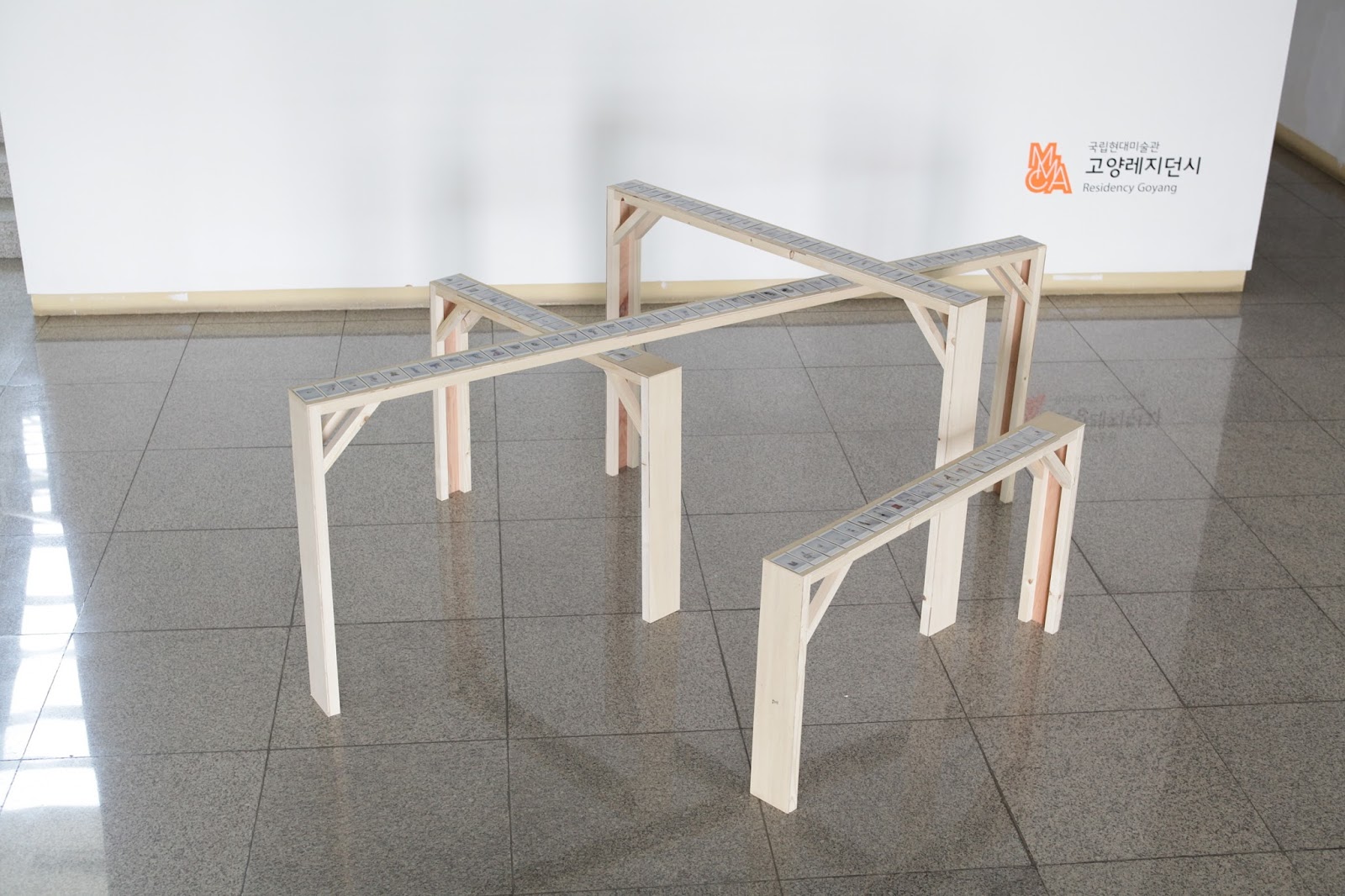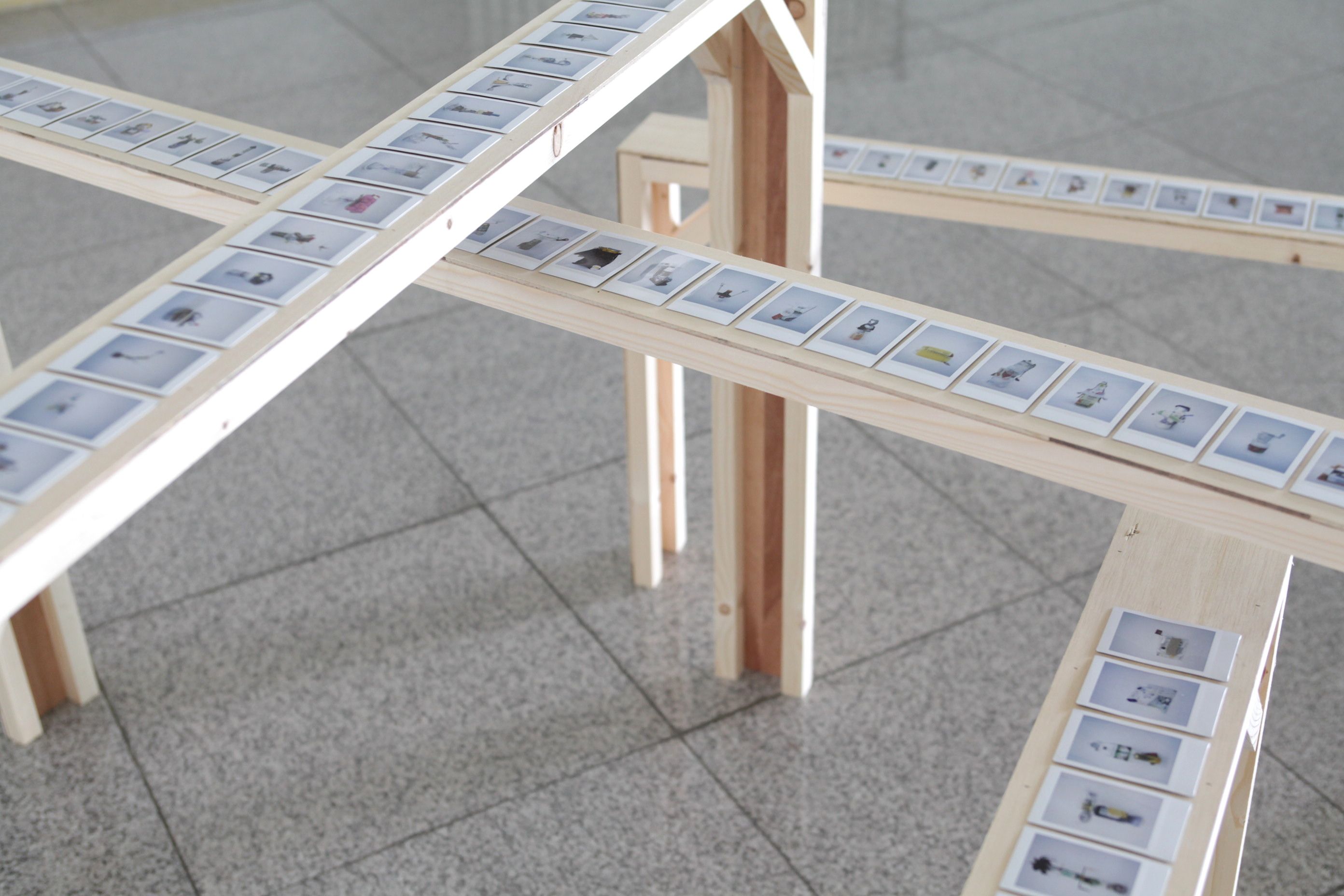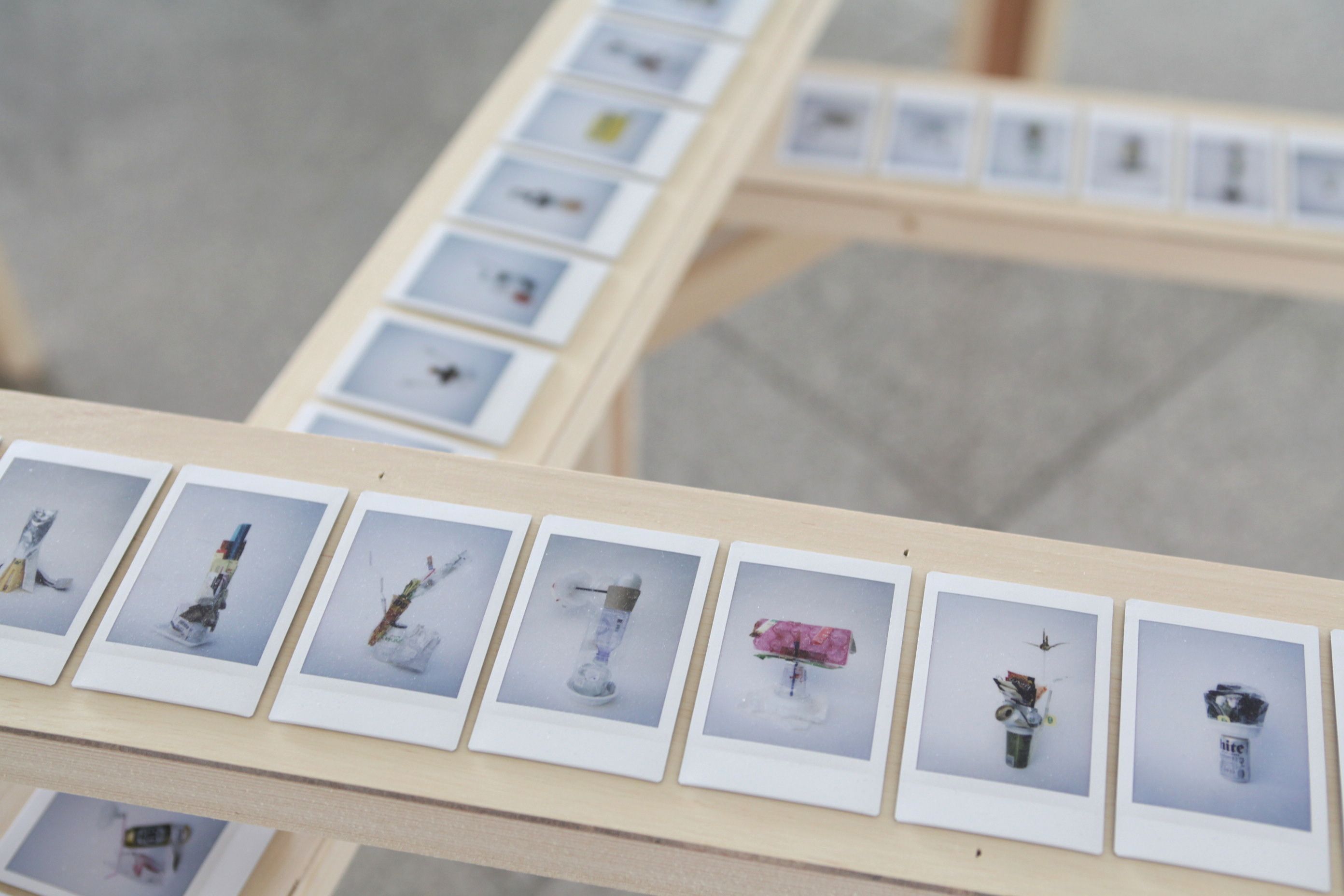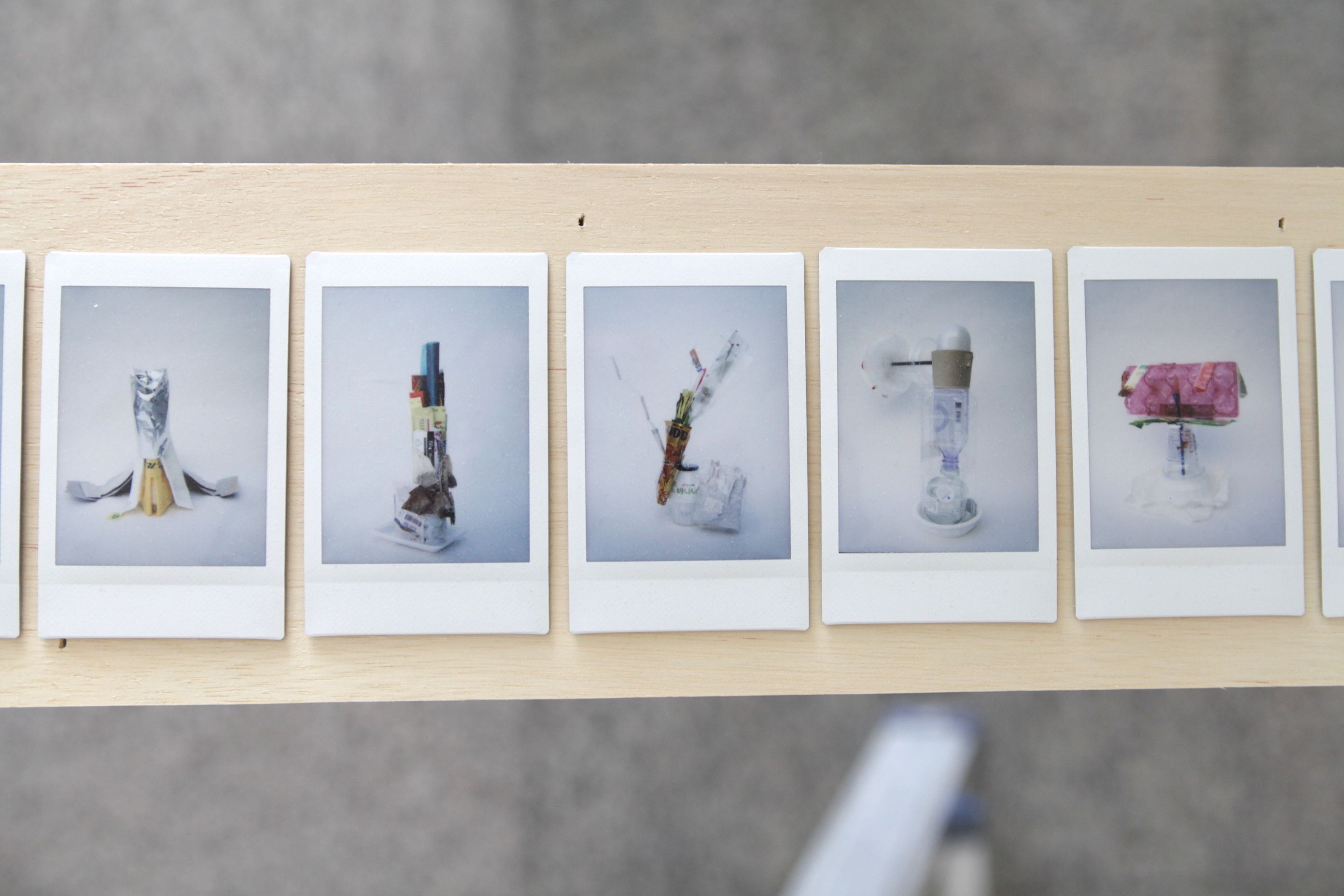MIDORI HARIMA






"Democracy Demonstrates - What I have consumed in 90 days in Korea"
2015
installation, variable dimensions, 8.5 x 5.5 cm each photo
CHEKI (Instant photography), wood
installation view from "The Big Scene: Seven sights" at MMCA Goyang, Korea July 23 - August 12th, 2015
Photo by: Nick McDonell
-Democracy Demonstrates - What I have consumed in 90 days in Korea-
Living in a city, every day I am creating garbage, and this made me curious about how much garbage I produce each day.
In the summer of 2015 I got the opportunity to stay in Korea for 90 days for the residency at MMCA Goyang, run by the National Museum of Modern and Contemporary Art in Korea.
Since I am visiting Korea for the first time, everything I see is new and even simple everyday activities like searching for and buying products is big deal for me. Perhaps it made me more aware of how, what, and why I consume everyday. Since the first day I arrived, I collected the garbage I produced, not having a particular purpose besides simple curiosity.
One day I came up with the idea of making one sculpture per day using the garbage I generated that day. I started making very casual constructions with my everyday garbage and this allowed me to reflect of my recent and past memories and experiences in Korea directly.
I walked around small alleys in Seoul and small farm roads in Goyang, I was fascinated by the Korean landscape. It made me nostalgic for Asian landscapes which are loosely constructed somewhere in between where natural and artificial forces meet. I tried to capture such organic landscape with my garbage and I also wanted to see my act of consuming transformed into a landscape.
One day, I was wandering in a Lotte Shopping Mart in Goyang and I saw an instant photo films called Cheki in a show case. It brought back memories of the late 90’s when I was an art school student, I was playing with the same kind of instant camera. I still have those small photos somewhere in my parent’s house in japan. I checked the history of the camera and found out that when the first CHEKI model came out in 1998 in Japan, it was really popular among with high school girls who were the marketing target of this product. Later it almost got to the end production in 2005 but in 2007 it became really popular in Korea because it was used in a Korean TV drama. Then the popularity spread to China, South East Asia, Japan and the U.S.
Beyond time and place, the circulation of commodities and my personal memory met. I wanted to use this camera and started taking photos of my everyday objects using the small instant polaroid-like film. I like the impermanency of the instant photograph as well as the impermanency of such analog technology. I like the time of waiting for an image to slowly appear on the surface and I like the smallness of the prints which was originally designed to be the same size as the Japanese high school student’s ID card. From the beginning, I decided that I would eventually discard the objects so that each time I tried to take the best shot possible, as if I am taking the portrait of someone who will soon be gone forever.
I started this project as my personal documentation as well as a simple observation of my daily act of consuming. This became also a personal practice of democracy for me by introducing to art making a selection process based on a non-aesthetic sense that is used in daily life. When I make these objects, I use a different sense than that which I usually use in my art practice. From another perspective, sculpture can be made using the thinking that is involved in doing everyday tasks. Looking at the sculptures lined up on the floor, I felt that such a landscape is very democratic. They are not necessarily well constructed, all are different, colorful and very characteristic. I started seeing people in the sculptures and my curiosity expanded to how and what other people consume everyday and how they construct their landscapes.
I came to Korea to also develop another project which is also associated with garbage and the act of consuming. Over the last one year during my daily commute walking between my home, studio and work place in New York City, I have been observing litter on the street and documenting them with the surrounding scenery. By doing that, I realized that there is a lot of information behind the garbage. It shows me many things such as a social structure, history, economic system, distribution system, production process, classism, our desires and ideology. Garbage is something invisible, usually it almost never really seen. We don’t see or pay attention to something that no longer serves a function for us after consuming its contents.
During the process of observing garbage, I got attracted to crafts based on the idea of recycling. One type of this craft is done by mothers and another by farmers. I see a quite a few objects on farms in Goyang, which are made from garbage and have a new function. I also often heard from woman around me that are raising kids that it is fundamentally lonely work. Many of them also commented that making something by hands made them feel connect to the society and helped to ease their loneliness. Mother craft is also based on the idea of recycling and the crafts have functions. It was very touching for me to realize that there are people who can imagine functions for supposedly nonfunctional objects and these people are living in somewhat invisible positions in society although they do create things in a concrete sense.
I have started to invite people to participate in this garbage project. I want to share the process of transforming garbage to sculpture, and sculpture to small precious photographs. Through the process, in fact, I want to share the process of transforming our conscious/unconscious so that art can have a function.
-Midori Harima, July 2015
민주주의의 발휘 - 내가 한국에서의 90일 동안 소비한 것들
(Democracy Demonstrates - 내가 한국에서의 90일 동안 소비한 것들)
도시에서 살아가는 나는 매일 끊임없이 쓰레기를 만들어낸다. 나는 내가 하루에 얼마만큼의 쓰레기를 생산하고 있는지 궁금증이 들곤 했었다.
2015년에 나는 한국의 국립현대미술관 고양레지던시에서 90일간 체류할 기회를 얻었다. 한국을 처음 방문하는 것인 만큼 눈에 보이는 모든 것이 새로울 뿐 아니라, 무언가를 찾고 구입하고 만드는 아주 간단하고 평범한 일조차도 쉽지가 않았다. 어쩌면 이 때문에 나는 내가 매일같이 어떻게, 무엇을, 왜 소비하는지에 대해 보다 의식을 하게 되었던 듯하다. 처음 도착한 날부터 나는 호기심 외의 별다른 목적 없이 쓰레기를 계속 모으기 시작했다.
그러던 어느 날 문득, 하루 동안 생산된 쓰레기를 이용하는 조각을 하루에 하나씩 만들면 좋겠다는 생각이 들었다. 나는 매일의 쓰레기를 이용하는 캐주얼한 조각들을 만들기 시작했다. 이는 내가 한국에서 경험한 근래의 기억과 지난 기억들을 직접 되돌아볼 수 있게 했다.
나는 서울의 좁은 골목들과 고양의 작은 시골길들을 걸어 다니며 한국의 풍경에 매료되었다. 이는 나에게 자연과 인공의 힘이 만나는 지점 어딘가에서 헐겁게 형성되어 있는 아시아의 풍경에 대한 향수를 불러왔다. 나는 나의 쓰레기 조각에 이러한 유기적 풍경을 담아내고자 했으며 또한 나의 소비 행위를 풍경으로서 보고 싶었다.
어느 날 고양의 롯데마트를 돌아다니던 중 나는 진열 선반에서 ‘CHEKI’라고 불리는 즉석사진 필름을 보았다. 이는 90년대 후반 내가 미술학교 학생이던 시절, 비슷한 즉석 사진기를 가지고 놀던 기억을 떠올리게 했다. 일본의 부모님 집 어딘가에 아직도 그때 찍은 작은 사진들이 남아있다. ‘CHEKI’의 역사를 확인해본 결과 나는 이 모델이 1998년에 일본에 처음 나왔으며 이 물건의 마케팅 대상이었던 고등학교 여학생들 사이에서 굉장히 인기가 좋았다는 사실을 알 수 있었다. 이후 2005년 무렵에는 거의 단종이 되었지만 2007년에 한국의 한 TV드라마에 나오면서 이번에는 한국에서 굉장히 인기를 끌었다. 이러한 인기는 중국과 동남아시아, 일본, 그리고 미국에까지 퍼졌다.
시간과 공간을 넘어 상품의 순환과 내 개인의 기억이 만난다. 나는 이 카메라를 사용하고 싶은 생각이 들어 나의 일상의 사물들을 이러한 작은 즉석사진으로 찍어대기 시작했다. 나는 이러한 즉석 사진의 일시성, 그리고 아날로그 기술의 일시성을 좋아한다. 나는 사진의 표면에 이미지가 서서히 떠오르는 동안의 기다리는 시간이 좋으며 일본 학생증 카드의 크기에 똑같이 맞춰 디자인된 인화물의 작은 크기가 좋다. 처음부터 물건들을 결국 버릴 생각이었기 때문에 나는 곧 영원히 사라질 사람들의 초상사진을 찍듯 매번 최선을 다해 최고의 사진을 찍고자 노력한다.
나는 이 프로젝트를 개인적 기록물이자 나의 일상적 소비 행위에 대한 단순한 관찰로서 시작하였다. 그렇지만 이처럼 미술을 만드는 작업에 비 미학적인 일상의 선택 과정을 도입시키는 것은 나에게 있어 또한 개인적인 민주주의 실천이 된다. 이 오브제들을 만들 때 나는 일반적으로 내가 미술 작업에 사용하는 것과는 다른 감수성을 이용한다. 다르게 보면 일상의 감수성으로 조각을 만드는 것이 가능하다. 바닥에 늘어놓아있는 조각들을 보며 나는 이 풍경이 굉장히 민주적이라는 생각을 했다. 다들 특별히 잘 만들어지지도, 모두 다르지도, 색이 화려하거나 딱히 개성적이지도 않다. 사람들을 보면서 나의 호기심은 다른 사람들을 어떻게 그리고 무엇을 매일같이 소비하고 그들의 풍경을 만들어 나가는지로 확장된다.
나는 쓰레기 및 소비행위와 연관된 또 하나의 프로젝트를 발전시키기 위해 한국에 왔다. 지난 한 해 동안 나는 뉴욕시의 집과 작업실, 사무실 사이의 통근 길을 걸어 다니며 거리의 쓰레기를 관찰하고 이를 풍경과 함께 기록하였다. 이 행위를 지속하면서 나는 쓰레기의 뒤에 굉장히 많은 정보가 있다는 것을 깨달았다. 이것에서부터 나는 사회구조, 역사, 경제체계, 분배체계, 생산과정, 계급주의, 우리들의 욕망과 이상과 사상 등이 보게 된다. 쓰레기는 보이지 않는, 다시 말해 일반적으로 절대 거의 보지 않게 되는 무엇이다. 우리는 더 이상 기능하지 않거나 내용물을 소비하고 난 나머지에 대해선 보지도 신경을 쓰지도 않는다.
쓰레기를 관찰하는 이러한 과정 속에서 나는 재활용의 개념에 기반을 하는 공예에 마음이 끌렸다. 하나는 나의 어머니에 의한 것이고 다른 하나는 농민들에 의한 것이다. 고양의 농원들에서 나는 쓰레기를 재활용하여 만들어 졌으면서 기능적인 물체들을 상당수 보게 된다. 나는 또한 내 주변의 여자들로부터 아이들을 키우는 것은 근본적으로 외로운 일이라는 이야기를 자주 들었다. 더불어 그들 중 많은 수는 손으로 무언가는 만드는 일이 그들에게 사회와 이어져 있다는 느낌을 들게 하고 외로움을 달래는데 도움이 된다고도 이야기했다. 어머니의 공예들 중 상당수는 이 재활용이라는 기념에 기반을 하고 있을 뿐 아니라 기능이 있다. 이른바 기능이 없는 물건의 활용도를 상상해낼 수 있는 누군가가 - 엄밀히 말해 사실 엄연히 생산자임에도 - 이처럼 사회의 보이지 않는 위치에서 살아가고 있다는 사실은 나에게 굉장히 감동적이다.
나는 이 쓰레기 프로젝트에 사람들을 초대하는 것에 점점 관심이 간다. 나는 쓰레기로부터 조각으로, 조각으로부터 작고 소중한 사진으로의 변환 과정을 공유하고 싶다. 이 과정을 통해 나는 미술이라는 것이 기능을 가길 수 있다고 우리의 의식/무의식을 변환하는 과정을 공유하고 싶다. 나는 이 프로젝트가 당신에게 새로운 관점을 제공하기를, 그리고 당신의 참여가 확장된 풍경의 건설에 있어 멋진 추가요소가 되기를 희망한다.
Democracy Demonstrates - 90日間韓国で私は何を消費したか
都市の暮らしの中で、日々自分は一体どれくらいのゴミを出すのかという事にずっと興味があった。
2015年の夏、韓国のMMCAコヤンレジデンシーにて90日間の滞在制作をする機会を持つ事ができた。
韓国を訪れるのは初めてだったこともあり、目にするもの全てが目新しく、単純な日常の行為、例えば必要な生活用品を探して買うという事すらも、自分にとってはそのひとつひとつが大事であった。この環境の変化は、何を、どのように、なぜ消費するのかという事に対し、私をより自覚的にさせた。韓国に到着した日から、はじめの単純な興味以外は特にこれといった目的もなく、自分が消費した後に出たゴミを保管し続けていた。
ある日、一日に自分が消費した分のゴミで、一つのオブジェを作ったらどうかというアイデアを思いついた。毎日のゴミを組み合わせる事で毎日一つのオブジェを作り始めた。このラフな制作方法により、韓国での現在進行形の経験や、近い過去の記憶をダイレクトに制作に反映することができたのではないかと思う。
ソウルの路地やコヤンの農道を歩いては、その風景に足を止めて見入ることが何度もあった。自然と人工物の間にゆるやかに構成されたアジアの風景に対する憧憬と、その有機的な風景を一つ一つのオブジェに再現しようと試みた。同時に自分の消費行為自体を風景に変換し、見てみたいとの思いもあった。
ある日、コヤンの町中のロッテマートを散策していて、ガラスケースの中に、富士フィルムのチェキというインスタントカメラ用のフィルムが売られているのが目に留まった。90年代の終わり頃、自分が学生だった頃に、同じような小さなサイズのインスタントカメラで遊んだ記憶、それらの写真が実家のクローゼットのどこかに保管してあることが思い起こされた。そのカメラについての歴史を調べてみると、最初のモデルが1998年に発売され、発売と同時に女子高生の間で大人気となった。ブームが完全に去った2005年頃には、製造中止に追い込まれる直前にまで売り上げが落ちたが、2007年に韓国ドラマで小道具として使用された事を機に、韓国で爆発的な人気となり、その後中国、東南アジア、日本、アメリカと人気が飛び火していって今に至る。
チェキとの韓国での遭遇は、商品の流通と流行と個人的な記憶とが、時代と場所を超えて再会した瞬間でもあった。このカメラを使用して、毎日のオブジェをインスタント写真に収めるということを始めた。インスタント写真の非永久性、アナログテクノロジーの一時性、イメージが徐々に表面に現れてくるのを待つ時間、当初のマーケンティングターゲットであった女子高生の生徒手帳に入る大きさにデザインされた写真の小ささ等に心を惹かれた。始めた時は、写真に収めた後はオブジェは廃棄しようと思っていたので、毎回ベストな写真を撮る事を心がけた。それはまるで、もうすぐ居なくなってしまう人の最期のポートレイトを撮るような感じだった。
このプロジェクトは、生活の私的な記録であり、自分の日常の消費行為の単純な観察からはじまったものである。また、美的な価値判断には基づいていない、日常的になされる日々の選択の過程を制作に持ち込む事は、自分にとっては個人的にデモクラシーの練習でもあった。これらのオブジェを作るとき、普段制作に使っている感性とは違うものを、意識的に導入するように心がけた。日常的な些事に動員される考え方に基づいても作品は作られうる。床に無造作に並べられたオブジェを眺めながら、この風景はとても民主的であると思った。一つ一つは、特に巧く作られている訳ではなく、夫々違っていて、カラフルで、特徴がある。それらはまるで人間のようで、私のゴミに対する興味は、他の人びとは、日々何をどのように消費し、どのような風景を構成しているのかという、人びとへの興味へと移行していった。
韓国へやってきたのは、ゴミと消費に関わるもう一つのプロジェクトを発展させる為でもあった。2014年の始めから、ニューヨークの自分の生活圏内、自宅、仕事先、スタジオの往復の途中で、道に落ちているゴミを、その周囲の環境も含めて記録観察するということをしている。このことは、ゴミの背後にある、社会構造、歴史、経済システム、商品流通システム、製造過程、階級社会、私たちの欲望やイデオロギー等の膨大な情報を私に見せてくれた。ゴミはそこにありながら、見られていない。私たちは、自分にとって有用である中身を消費した後、機能の失われたゴミには通常注意を払わない。
ゴミの観察を続けていく中で、たまに出会うリサイクルされたゴミに目が留るようになった。その中でも、農家の人と母親によって作られたものに特に心を惹かれた。コヤンの農道や畑や農家の庭先では、リサイクルられることで、新たに機能しているゴミをよく目にした。また、母親によって盛んに作られるクラフトもその多くがリサイクルという方法と、できた物何がしかの機能を持っていることが多いことに気がついた。自分の身近にいる母親達から、社会とは切り離されたような子育て中の孤独な奮闘について、また手仕事がその孤独を紛らわす手段となったことについてよく話を聞いていたこともあり、本質的な生産に従事する人びとが、社会的には見えにくい位置に置かれている事、そういった人びとが機能がないとされているものに機能を見いだす目を持っているということが、とても示唆的に感じられた。
ワークショップという形で、このゴミのプロジェクトに人びとに参加してもらうことを始めた。ゴミがオブジェになり、小さな写真になるという変換の過程を通し、自らの意識自体を変換させるというプロセス自体を共有できれば、アートが機能できるのではないかと考えて。
EXHIBITIONS
"The Big Scene: Seven sights" at MMCA Goyang, Korea July 23 - August 12th, 2015
Back
